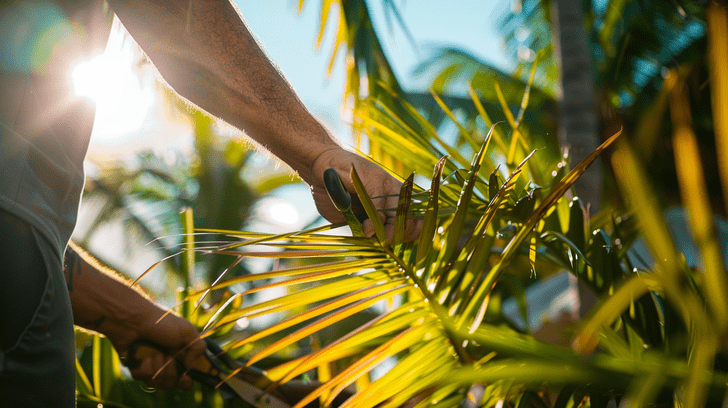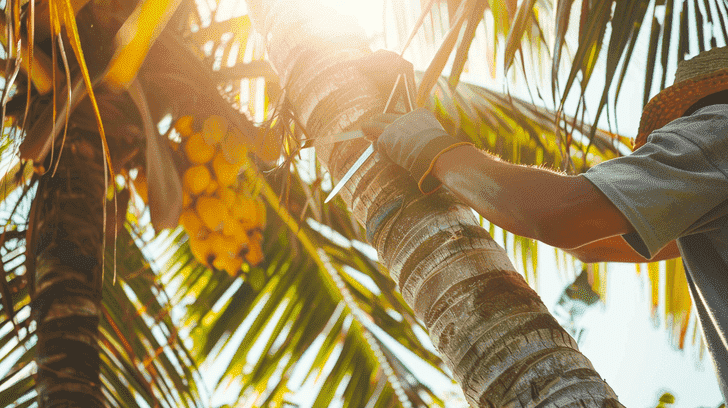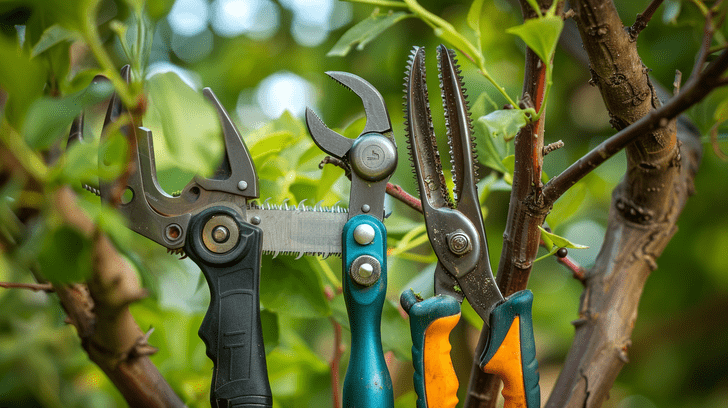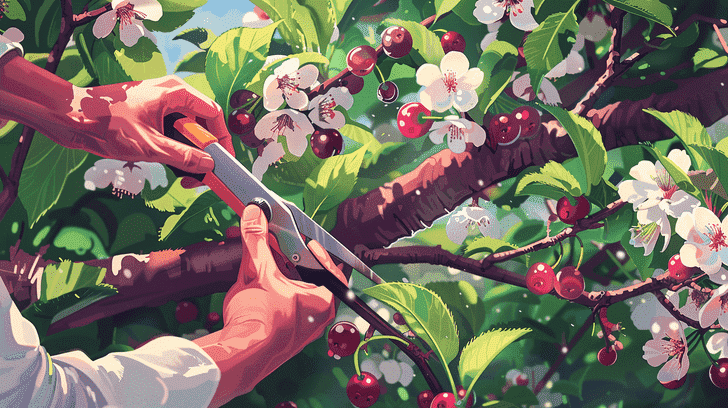Essential Guide to Palm Tree Trimming: Techniques and Timing
Mastering palm tree trimming techniques and timing is essential to guarantee your palm trees stay healthy and beautiful.
Identify dead fronds, use correct tools, and trim near the trunk without harming healthy leaves. Proper disposal is vital.
Consider late winter or early spring for trimming, avoiding active growth times. Stay mindful of your tree’s health and climate conditions.
Need more details on selecting tools, safe techniques, and post-trimming care?
This guide has you covered. Discover the secrets to keeping your palms thriving with expert advice on maintenance, when to hire pros, and FAQs.
Palm Tree Trimming
When it comes to palm tree trimming, understanding the importance of proper pruning is crucial. Many harbor misconceptions about how to care for palm trees, which can lead to ineffective trimming practices.
Importance of Proper Pruning
Proper pruning of palm trees is essential to guarantee their health, aesthetics, and overall well-being. When you prune your palm, focusing on removing dead or dying fronds is necessary.
These fronds not only detract from the beauty of the palm but can also harbor pests and diseases that can affect the health of the palm.
By trimming your palm correctly, you promote ideal growth and reduce the risk of potential hazards like falling fronds.
Additionally, regular pruning allows the palm to allocate resources more efficiently, leading to stronger and more resilient trees.
Common Misconceptions About Palm Tree Trimming
To guarantee successful palm tree trimming, it’s crucial to debunk common misconceptions surrounding this essential practice.
Here are some misconceptions you should be aware of:
- Palm trees don’t need trimming: Contrary to popular belief, palm trees do require regular trimming to maintain their health and aesthetics.
- Any tree service can trim a palm tree: Not all tree services are experienced in palm tree trimming; make sure you hire a specialist.
- Using any pruning tools is fine: Using improper pruning tools can damage your palm tree; always use the right tools for the job.
- Over-pruning helps the tree grow better: Over-pruning can actually harm your palm tree’s health, leading to stunted growth and increased vulnerability to diseases.
Assessing the Health of Your Palm Tree
You should pay close attention to signs that indicate your palm tree needs trimming, such as dead or yellowing fronds.
Also, be on the lookout for nutrient deficiencies, which can manifest as discolored or misshapen leaves.
Evaluating the health of your palm tree is essential in maintaining its overall well-being and ensuring its longevity.
Signs of Necessary Trimming
Evaluating the health of your palm tree involves closely examining its fronds for any signs of necessary trimming. When appraising whether your palm tree needs trimming, watch out for the following indicators:
- Yellowing Fronds: Yellow fronds can suggest a lack of nutrients or over-trimming.
- Brown or Wilting Fronds: Brown or wilting fronds may indicate dehydration or fungal infections.
- Crossing or Rubbing Fronds: Fronds that cross or rub against each other can lead to damage and should be pruned.
- Decaying Fronds at the Base: Decaying fronds at the base of the tree could be a sign of disease or pests.
Regularly inspecting your palm tree for these signs will help maintain its health and well-being.
Identifying Nutrient Deficiencies
Identifying nutrient deficiencies in your palm tree is essential for maintaining its overall health and vitality.
One common issue is potassium deficiency, which can manifest as yellow spotting on older fronds. If you notice such symptoms, consider adding a fertilizer specifically formulated for palms that’s high in potassium.
Additionally, thick fronds or slow growth may indicate a lack of essential nutrients in the soil. Regularly testing the soil and providing appropriate supplements can help address these deficiencies.
It’s also important to monitor for signs of soil-borne diseases, as these can impact the nutrient uptake of your palm tree.
Proper Timing for Trimming
To guarantee your palm tree stays healthy and vibrant, it’s essential to trim it at the right times. Understanding the best seasons for pruning and the growth cycles of your palm is key to proper maintenance.
Best Seasons for Pruning
For effective palm tree trimming, understanding the best seasons for pruning is essential to promote ideal growth and health of the tree.
When it comes to trimming palms, timing is vital. Here are some key points to keep in mind:
- Spring: Ideal time for most species of palm trees.
- Early Summer: Suitable for palms that grow rapidly.
- Fall: Best for cold-sensitive palms.
- Avoid Winter: Generally not recommended due to slower growth.
Understanding Palm Growth Cycles
Understanding the palm tree growth cycles is crucial for determining the proper timing for trimming to promote the best health and development of the tree.
Palm trees have two main growth cycles: the active growth phase and the dormant phase.
During the active growth phase, which typically occurs in spring and summer, the palm tree produces new fronds.
This phase is the best time for trimming because it allows the tree to recover quickly.
Trimming during the dormant phase, which is usually in fall and winter, can stress the tree as it focuses on root growth rather than producing new fronds.
By following the palm growth cycles, you can ensure that the timing of your trimming aligns with the tree’s natural processes, leading to healthy fronds and overall tree wellness.
Selecting the Right Tools
When selecting the right tools for trimming your palm tree, it’s essential to take into account the size of the fronds you’ll be working with.
Different tools are designed for various frond sizes, ensuring a clean and efficient trimming process.
Additionally, don’t forget the importance of sterilizing your tools to prevent the spread of diseases among your palm trees.
Tools for Different Frond Sizes
Selecting the appropriate tools for various frond sizes is essential for efficient and effective palm tree trimming. When dealing with different palm tree frond sizes, consider the following tools:
- Pruning Saw: Ideal for cutting through thick and sturdy fronds.
- Large Clippers: Perfect for trimming medium to large-sized fronds with precision.
- Hand Saw: Useful for branches that are too large for clippers but not thick enough for a pruning saw.
- Serrated Knife: Great for delicate trimming of small fronds or for detail work.
Importance of Tool Sterilization
To guarantee the effectiveness of your palm tree trimming tools, proper sterilization is essential for maintaining their efficiency and preventing the spread of diseases among your trees.
When pruning your palm trees, it’s important to sterilize your tools to avoid transmitting pests or diseases from one tree to another.
You can easily sterilize your tools with a household cleaner to make sure they are clean and safe to use.
Regularly cleaning and sterilizing your tools after each use will help keep your palm trees healthy and thriving.
By incorporating this simple step into your palm tree pruning routine, you can protect your trees from potential infections and promote their overall well-being.
| Benefits of Tool Sterilization | Importance of Sterilizing Tools | Tips for Effective Sterilization |
| Prevents spread of diseases | Maintains tool efficiency | Use household cleaner |
| Protects trees from pests | Promotes tree health | Clean tools after each use |
| Ensures clean and safe tools | Prevents infections | Regularly sterilize tools |
Safe Trimming Techniques

When trimming palm trees, it’s essential to follow specific steps to guarantee the tree’s health and aesthetics.
By employing safe trimming techniques, you can prevent unnecessary damage to the palm.
Let’s explore a step-by-step process that will guide you in achieving a successful palm tree trim.
Step-by-Step Trimming Process
Begin the palm tree trimming process by ensuring you have the necessary safety equipment and tools available for a successful and safe trimming experience.
When you’re ready, follow these steps for a precise trim:
- Assess the Palm: Identify which fronds need trimming and plan your approach.
- Prepare the Area: Clear the space around the palm tree to avoid obstacles.
- Use Proper Technique: Cut fronds at the base near the trunk without harming it.
- Regular Maintenance: Trim your palm every 6-12 months to keep it healthy and attractive.
Avoiding Damage to the Palm
By employing careful and precise cutting techniques, you can guarantee minimal damage to the palm tree during the trimming process.
When it comes to pruning your palm tree, following proper tree care practices is essential to prevent damage and promote healthy growth.
Here are some key trimming tips to help you maintain the health and beauty of your palm tree:
| Trimming Tips | Description |
| 1. Sharp Tools | Always use sharp and clean pruning tools. |
| 2. Avoid Over-Pruning | Trim only dead or damaged fronds to avoid stress. |
| 3. Cut at the Node | Make cuts at the base of fronds near the trunk. |
| 4. Monitor Growth | Regularly inspect your palm tree for trimming needs. |
Post-Trimming Care
After trimming your palm tree, paying attention to immediate aftercare steps is vital to guarantee its health and growth.
Additionally, engaging in long-term maintenance practices will help your palm tree thrive and remain vibrant over time.
Providing your palm tree with the necessary care post-trimming is imperative to promote its well-being and longevity.
Immediate Aftercare
Consider implementing these steps for effective post-trimming care to maintain the health and aesthetics of your palm tree.
- Remove Dead or Damaged Fronds: Trim any dead or damaged fronds to prevent diseases and pests from infesting the tree.
- Water Adequately: Guarantee the palm receives sufficient water, especially during the first few weeks after trimming, to support recovery.
- Fertilize Sparingly: Use a balanced fertilizer specifically formulated for palm trees to promote new growth without overstimulating.
- Monitor Green Fronds: Keep an eye on the remaining green fronds for any signs of stress or nutrient deficiencies, and address them promptly.
Long-Term Palm Maintenance
Monitoring the overall health of your palm tree becomes important in ensuring its long-term vitality and appearance post-trimming.
Regular pruning, proper health maintenance, and strategic trimming techniques are essential for the well-being of your palm tree.
By following a consistent schedule and paying attention to the timing of each task, you can promote healthy growth and prevent potential issues.
| Aspect | Description | Importance |
| Regular Pruning | Trimming dead fronds and flowers. | Promotes growth |
| Health Maintenance | Checking for pests and diseases regularly. | Prevents problems |
| Trimming Techniques | Using sharp tools and avoiding over-pruning. | Ensures tree health |
When to Hire a Professional
If you find yourself facing palm tree trimming challenges beyond your expertise or comfort level, it’s time to contemplate hiring a professional.
Scenarios like tall trees, intricate pruning needs, or proximity to power lines often warrant the skills of experienced tree service providers.
Choosing the right professionals can guarantee the safety of your property and the health of your palm trees.
Scenarios Requiring Professional Help
When facing complex palm tree issues beyond your expertise, hiring a professional arborist becomes essential. Trained professionals can handle challenging situations with precision and guarantee the health and safety of your palm trees.
Here are some scenarios where seeking the help of an expert tree service is highly recommended:
- Severe pest infestations that are difficult to control
- Large palm trees requiring extensive trimming or removal
- Tree diseases that may spread to other plants in your garden
- Emergency situations like storm damage or fallen trees
These are instances where the knowledge and skills of a professional tree specialist are vital to effectively address the issues and maintain the well-being of your palm trees.
Choosing the Right Tree Service
To guarantee the proper care of your palm trees, selecting the right tree service is important for maintaining their health and appearance.
When your palm trees need trimming, especially in regions like Las Vegas where precise trimming practices are vital due to the climate, it’s wise to opt for professional help.
Tree pruning is a task that requires expertise to make sure the trees remain healthy and aesthetically pleasing.
Choosing the right tree service provider can make a significant difference in the outcome of your palm tree maintenance.
Look for certified arborists with experience in palm tree care and trimming. They’ll have the necessary knowledge and tools to trim your palm trees correctly, promoting their growth and longevity.
FAQ – Palm Tree Trimming
When should a palm tree be trimmed?
Pruning your palm tree at the best time is essential for its health and appearance. When it comes to trimming your palm tree, timing is essential. Here are some key points to keep in mind:
- Season: Trimming is most effective at the beginning of the growing season.
- Appearance: Regularly inspect your palm tree for dead fronds and trim as needed.
- Health: Trimming can help prevent diseases and pest infestations.
- Safety: Remove any hanging or potentially hazardous fronds promptly.
What happens if you don’t trim palm trees?
Neglecting to trim palm trees can lead to a variety of issues that compromise the health and aesthetics of the tree.
When palm trees aren’t trimmed regularly, dead fronds accumulate, creating a breeding ground for pests and diseases.
This can result in a decline in the overall health of the tree, making it more susceptible to infections and infestations.
Additionally, overgrown palm trees can become safety hazards during storms or high winds, posing a risk to your landscape and property.
Failure to trim palm trees may also lead to the excessive growth of petioles, affecting the tree’s appearance. In severe cases, untrimmed palms may require costly tree removal services to address the damage caused by neglect.
How to trim sides of a palm tree?
To trim the sides of a palm tree effectively, start by identifying the dead or yellowing fronds that need to be removed.
When trimming, it’s important to follow the right techniques to guarantee the health and aesthetics of the tree. Here’s how you can trim the sides of a palm tree properly:
- Inspect the Palm Fronds: Look for any dead or discolored fronds that need to be trimmed away.
- Choose the Right Time of Year to Trim: Aim to trim palm trees in late winter or early spring.
- Cut Fronds at Least 2 Inches from the Trunk: Make clean cuts to avoid damaging the tree.
- Trim Away Any Overlapping Fronds: Ensure proper airflow and sunlight penetration by removing excess foliage.
Are palm trees self pruning?
Palm trees don’t self-prune their fronds; regular maintenance is essential to keep them healthy and visually appealing.
Unlike some trees that naturally shed dead leaves, palm trees retain their old fronds. If these dead fronds aren’t removed, they can create a thatch that harbors pests and diseases, weakening the tree over time.
Additionally, not pruning can hinder the palm’s ability to produce flowers and fruits. The accumulation of dead fronds also increases the risk of falling, potentially causing damage or injury.
To prevent these issues, it’s important to schedule regular trimmings for your palm tree, ensuring it remains in top condition and safe for both your property and surroundings.
Conclusion
In conclusion, proper palm tree trimming is essential for maintaining the health, appearance, and longevity of your palm trees.
By understanding the importance of pruning, dispelling common misconceptions, assessing the health of your trees, using the right tools, following safe techniques, and providing post-trimming care, you can ensure the optimal growth and beauty of your palm trees.
If unsure or for complex trimming needs, it is advisable to seek the expertise of professional tree services to guarantee the well-being of your palms.







